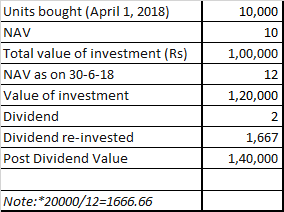
Mutual funds are one of the popular investment avenues to park your money. Believing in the concept of letting your money work for you rather than keeping it idle in your bank account or investing in a fixed deposit with a very low rate of returns, mutual funds are a better option for wealth creation. To invest your money through mutual funds there are broadly three categories:
- Growth Plan
- Dividend Plan
- Dividend Reinvestment Plan
Any option in mutual funds can be chosen depending upon your need and requirement suitability of the investor. So basically investment in a mutual fund, irrespective of its categories like equity, debt, or hybrid, offers a variety of options to choose from. A dividend option is a payout option in which dividend distributions given by the mutual fund are directly swept into the linked bank account of the investor. So now, the next question that arises is to choose between Growth Vs Dividend Reinvestment Mutual Fund.
Growth Plan
It’s a widely used basic plan, where investors do not get any payouts but the profits incurred on the investment in a mutual fund gets reinvested. Thus, with an increase in the market, the NAV of the fund also gets increased. The option of a growth plan works best in the case of long-term investment because in this case, the power of compounding works beautifully. Especially, if the investor is opting for equity funds, it entails risk which time horizon can even out but will give tremendous returns over some time.
Now, in the discussion of Growth Vs Dividend Reinvestment Mutual Fund, let’s understand the dividend reinvestment option.
Dividend Reinvestment Plan
Unlike in the dividend plan, the dividend earned is paid out to investors in cash but in the reinvestment option is a combination of growth and dividend plans. The dividend is reinvested in the same mutual fund but at a lower NAV reduced to the extent of dividend payout. Thus, investors get more units issued of the invested mutual fund. But this option has been discontinued on most of the ELSS schemes.

Also, if we compare the Growth Vs Dividend Reinvestment option based on tax purposes, one needs to evaluate in different scenarios. If investing for long-term financial planning in an equity fund, a growth plan works well with the power of compounding and tremendous wealth creation on the investment after a certain period. But if we talk about debt funds, holding for less than 3 years we incur 28.33% of DDT (Dividend Distribution Tax), in case of dividend reinvestment option which is better, rather than paying STCG. But if in case, holding a short term liquid mutual fund for more than 3 years than paying an STCG of 20% is more viable than DDT.
People often ask
- What is dividend and growth?
- Is dividend reinvestment taxable?
- Do mutual fund dividends have to be reinvested?
- How do I avoid paying tax on dividends?
The investor allows the fund company to invest the dividend payments in more securities to grow their money. With dividends, fund managers are allowed to use dividend payments to buy more shares in the fund on behalf of the investor.
Dividends are taxed annually and they have no relation to dividend re-investment, so dividend re-investment is taxed as an additional principal amount.
No, it completely depends on the investor if, he or she wants to re-invest the mutual funds’ dividends or not.
As per section 10(35) of the Income Tax Act, any income received by an individual/HUF as a dividend from a debt mutual fund scheme or an equity mutual fund scheme is fully exempt from tax.
Conclusion
So, concluding, which is the best option to choose between Growth Vs Dividend Reinvestment Plan, there is no sense to opt for the dividend reinvestment option if you are planning for long term investment, growth plans are much simpler. But, in case of short duration (especially debt funds), dividend reinvestment can be chosen. So, the decision to choose a plan, all depends on the investor's time horizon to invest, tax slab, and of course their suitability.